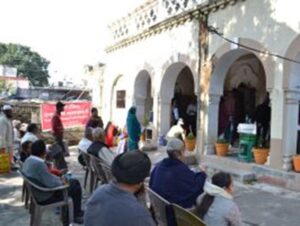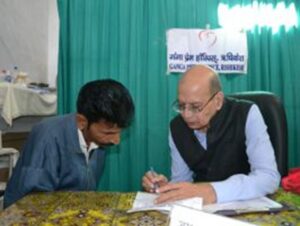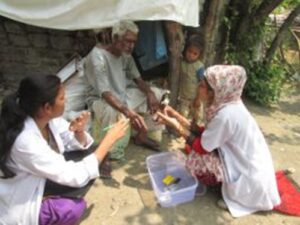Annual Report 2017-18:
GPH Annual Report 2017-18: Cancer Clinics
Ganga Prem Hospice hosted twelve charitable cancer clinics in Rishikesh during the April 2017- March 2018 operational year. A total of 1018 patients received care at these clinics, with an average for the year of 85 patients per clinic. The largest clinics (99 patients) were in May 2017 and February 2018, and the smallest (61 patients) was in the month of March 2018. About half of the total patients were from Rishikesh, 232 from Dehradun, 73 from Haridwar, 99 from cities in the plains region, and 94 from towns or villages in the Himalayan hills. The male-female ratio of patients was 62:38, almost exactly the same as in the previous year. GPH patients are overwhelmingly Hindu (90% at the 2017-18 clinics,) which is a simple reflection of the greater demographics of the Uttarakhand Himalayan region. Other religions represented were Sikh, Muslim, Jain and Christian in numbers of descending order.


While the primary aim of the free GPH clinics is the diagnosis and follow-up care of cancer, anyone with health concerns is granted a doctor’s consultation at the clinic. This year 60% of the total patients seen at the clinics were suffering from cancer, and amongst these 13% were terminally ill cancer patients. An additional 5% presented symptoms associated with cancer and these were sent for appropriate diagnostic testing as a first step in their continued care. As usual, head and neck cancers were by far the most prevalent cancers observed at the clinics, accounting for almost 48% of the total with 260 cases. The second most common category was breast cancer with 81 cases, followed by abdominal cancers (68,) lungs (43,) reproductive organs (26,) bones (6,) and blood (6.) Other miscellaneous cancers afflicted the remaining 57 patients.


The GPH clinic staff is augmented by a team of local and visiting doctors and volunteers, with at least one oncologist at every clinic. There were as many as ten doctors in attendance at one clinic, with an average of seven doctors per clinic, including oncologists, palliative care specialists, gynecologists, dentists, general practitioners and an onco-psychiatrist. Clinic operational activity benefited from the work of between 8-12 volunteers (including volunteer doctors,) every month. Many of these were international visitors who joined the local regulars in their monthly service, and all find meaning in helping others in need through the Ganga Prem Hospice charitable clinics.
Home Care Statistics Summary for 2017-18
During the GPH operational year from April 2017- March 2018, the home care team made a total of 2054 visits to 186 different patients. 96 patients resided in Dehradun, 53 in Rishikesh, 34 in Haridwar and a few others in more distant towns. These figures reflect the relative size of the three cities, as well as travel distance for hospice staff, with three vehicles based in Rishikesh and one based in Dehradun for much of the year.
On average, there were a total of 171 visits per month, with April registering the most visits (311) and October the fewest visits (99.) As expected, variation in number of visits per month roughly corresponds with number of patients requesting home care: October had the fewest patients and April the second most patients. Additional variation in number of visits per month can be explained by fluctuations in available staff due to holidays or demands from other GPH activities such as rural outreach and in-patient care. When visiting medical professionals join the team for a period of weeks or months, home visits naturally increase in number.


Most (126 out of 186) of the home care patients were over the age of 50; fewest (6) were between the ages of 21 and 30. This year lung cancer was the most common type of cancer treated in the home care program (20 out of 186,) followed by breast (16,) ovary and tongue (12 cases each.) However, taken as a group, head and neck cancers numbering 47 cases (25%) were again by far the most prevalent category relative to any other category of cancer. This unfortunate statistic is also reflected in the GPH cancer clinic figures, and clearly linked to the prevalent use of tobacco products and paan products.
GPH also records the financial status of its patients and helps the poorest families receive additional aid in the form of free rations, hospital grants, school fees and so forth. Based on their income, most of the home care patients were categorized as Lower-Middle Class (69,) followed by Poor (49) and then Very Poor (24.) 43 patients were classified as Upper-Middle Class or Well-Off. The religious identity of GPH patients reflect the overwhelming Hindu majority of the Himalayan foothill region: 167 (90%) were Hindu, with the remaining ten percent following the Muslim, Sikh, Jain and Christian faiths.
A total of 16 different doctors, 13 nurses, 12 volunteers, a masseuse and 3 drivers joined the team at different times and for varying durations throughout the year to provide home care.
GPH Annual Report 2017-18: Inpatient Facility
The year 2017 was when the Ganga Prem Hospice project took the momentous leap of commencing its inpatient service.
In the first year (2017-18), forty-five terminally ill cancer patients were cared for at the hospice. There were 27 male patients and 18 female patients. They were given pain-relief, symptomatic care, and psychological and spiritual counselling and support.


Eight patients passed away at the facility, receiving professional hospice and palliative care at the most crucial time in their lives. Others were discharged from the hospice because their distressing symptoms were alleviated and they could now manage with home care while other patients left even in their last few days or hours of their life because their families wanted them to die at home.
Ganga Prem Hospice provided all-round support, right from the time a patient was admitted to the hospice, to supporting the patient’s family by counselling them, and if the patient passed away at the hospice, helping the family with the funeral service. For patients who had no close family to look after them, either during their stay at the hospice, or at death, the hospice team acted as their guardians, giving them company during their stay, and making funeral arrangements after their death, according to the patient’s religion and wishes.
Ganga Prem Hospice welcomed patients of all religions, and socio-economic backgrounds. This included destitutes and widows who had been abandoned by their families. All services were provided free-of-charge to all patients and to one carer if the patient was accompanied by anyone.


A vast majority of the patients (75%) were of the age group 41 and above, while two patients (4.4%) admitted to the hospice were under the age of twenty. One young stayed in the child care room for an extended period of time and receiving loving care from the entire hospice team of staff and volunteers.
While oral cancers and head & neck cancers formed the single largest majority of the types of cancers that inpatients suffered from, the other cancer categories were cancers of the gall bladder (liver and pancreas), lung cancer, gastro-intestinal malignancies, and gynaecological cancers.
